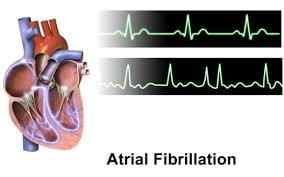Atrial Fibrillation: Causes, Symptoms, and Treatment Options
Atrial fibrillation (AFib) is a common heart rhythm disorder characterized by irregular and rapid heartbeats. It affects millions of people worldwide and can increase the risk of complications such as stroke, heart failure, and other cardiovascular problems. While AFib can be managed with proper treatment and lifestyle modifications, understanding its causes, symptoms, and treatment options is essential for effectively managing this condition. In this comprehensive guide, we’ll delve into the intricacies of atrial fibrillation, empowering you with the knowledge to recognize its signs, seek appropriate medical care, and take proactive steps to protect your heart health.
Understanding Atrial-Fibrillation: Atrial fibrillation occurs when the heart’s upper chambers (atria) beat irregularly and chaotically, leading to an erratic heartbeat. Instead of contracting in a coordinated manner, the atria quiver or fibrillate, compromising the heart’s ability to pump blood efficiently. This irregular heart rhythm can disrupt blood flow, increase the risk of blood clots, and potentially lead to complications such as stroke or heart failure.
Common Causes and Risk Factors: Atrial-fibrillation can be triggered by various factors, including:
- Age: The risk of developing AFib increases with age, particularly in individuals over 65 years old.
- Heart disease: Conditions such as coronary artery disease, heart valve disorders, heart failure, and cardiomyopathy can predispose individuals to atrial fibrillation.
- High blood pressure: Hypertension can strain the heart and increase the risk of atrial fibrillation.
- Obesity: Excess weight and obesity are associated with an increased risk of AFib.
- Sleep apnea: Obstructive sleep apnea, a condition characterized by interrupted breathing during sleep, is a risk factor for atrial fibrillation.
- Diabetes: Uncontrolled diabetes can contribute to cardiovascular complications, including atrial fibrillation.
- Thyroid disorders: Hyperthyroidism (overactive thyroid) or hypothyroidism (underactive thyroid) can increase the risk of AFib.
- Lifestyle factors: Excessive alcohol consumption, smoking, and a sedentary lifestyle can raise the risk of atrial fibrillation.
Symptoms of Atrial Fibrillation: The symptoms of atrial fibrillation can vary from person to person and may include:
- Palpitations or rapid heartbeat
- Irregular heartbeat or fluttering sensation in the chest
- Fatigue or weakness
- Shortness of breath
- Dizziness or lightheadedness
- Chest pain or discomfort
- Fainting or syncope (in severe cases)
It’s important to note that some individuals with atrial fibrillation may not experience any symptoms, known as silent AFib. However, even asymptomatic AFib can increase the risk of complications and requires medical attention.
Diagnosis and Treatment Options: Diagnosing atrial fibrillation typically involves a combination of medical history review, physical examination, electrocardiogram (ECG or EKG), and other diagnostic tests such as Holter monitoring, event monitoring, or echocardiography. Once diagnosed, the goal of treatment is to control heart rate, restore normal heart rhythm (sinus rhythm), and reduce the risk of complications.
Treatment options for atrial fibrillation may include:
- Medications: Antiarrhythmic medications, beta-blockers, calcium channel blockers, and blood thinners (anticoagulants) may be prescribed to control heart rate, maintain normal rhythm, and reduce the risk of blood clots and stroke.
- Cardioversion: Electrical cardioversion or pharmacological cardioversion may be performed to restore normal heart rhythm in individuals with persistent atrial fibrillation.
- Catheter ablation: Catheter ablation procedures may be recommended to selectively destroy abnormal heart tissue responsible for triggering atrial fibrillation and restore normal heart rhythm.
- Lifestyle modifications: Adopting heart-healthy lifestyle habits such as maintaining a healthy weight, exercising regularly, eating a balanced diet low in sodium and saturated fat, quitting smoking, limiting alcohol consumption, managing stress, and treating underlying medical conditions can help reduce the risk of atrial fibrillation and its complications.
Conclusion: Atrial-fibrillation is a common heart rhythm disorder that requires prompt diagnosis and appropriate management to reduce the risk of complications and improve quality of life. By understanding the causes, symptoms, and treatment options for AFib, individuals can take proactive steps to protect their heart health and minimize the impact of this condition. If you or a loved one experience symptoms of atrial fibrillation, it’s essential to seek medical attention promptly for proper evaluation and personalized treatment recommendations.
Thanks for visiting Gymbag4u.com
You may also love reading our following articles. Exploring the Link Between Intermittent Fasting and Heart Disease – GymBag4U and HPV and Heart Disease: A Looming Connection with Life-Saving Implications – GymBag4U and The Silent Culprit: Hidden Cholesterol Risk Raises Alarm as Lipoprotein(a) Emerges as Heart Attack Threat – GymBag4U and Foods to Lower High Blood Pressure: Your Guide to a Healthier Heart – GymBag4U
